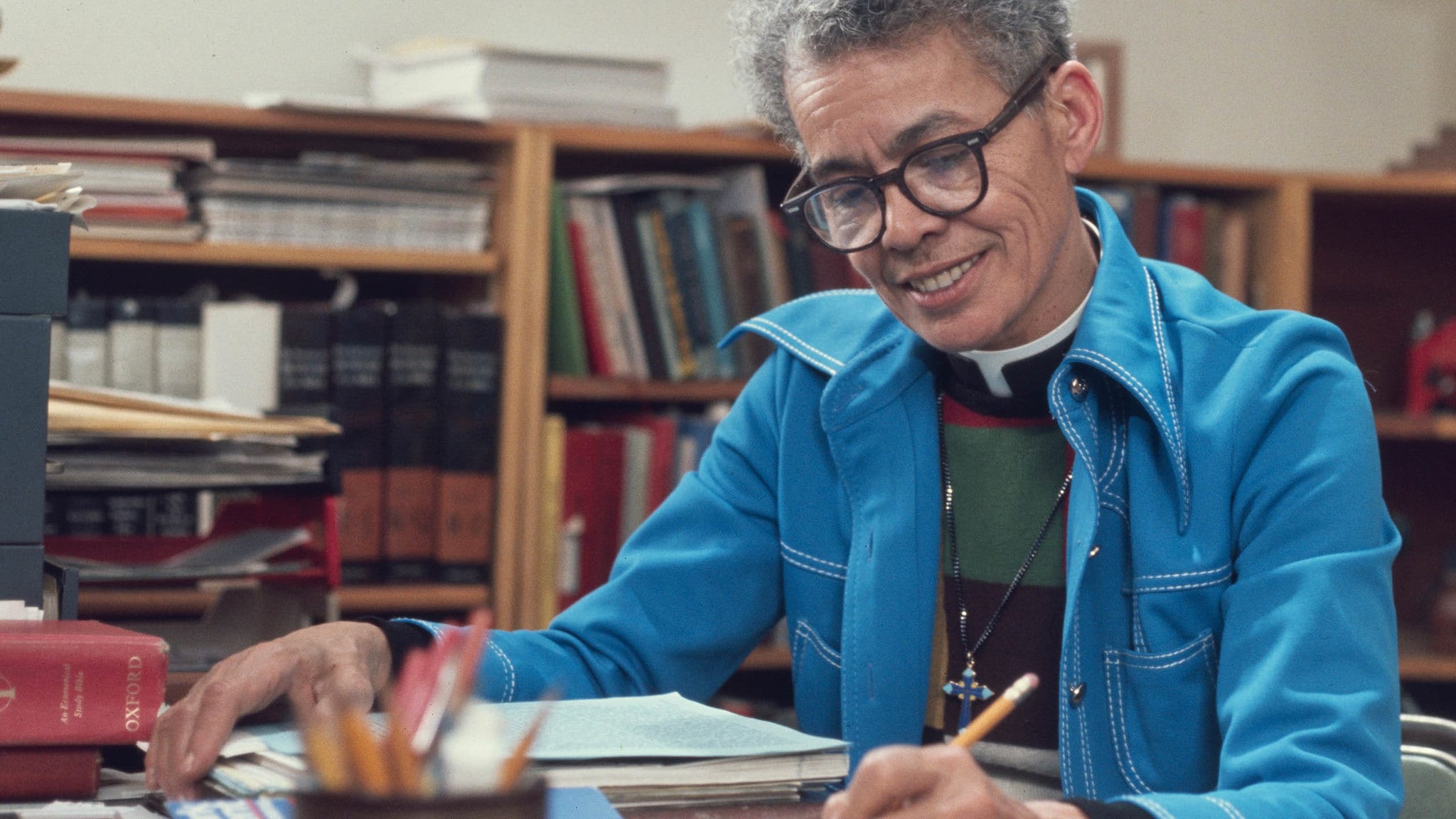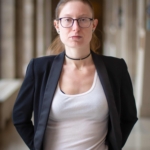Pauli Murray is the most incredible activist, poet, lawyer and priest—not to mention a Black non-binary queer role model—you’ve probably never heard of. Murray was a pioneer of racial and gender justice in both action and idea, sometimes decades ahead of more familiar names. My Name Is Pauli Murray, produced by Talleah Bridges McMahon and directed by Betsy West and Julie Cohen, is a new documentary that premiered at this year’s Sundance Film Festival that aims to bring Murray’s significance to a wider audience.
Some background: Murray was born in 1910 and was raised by an aunt, Pauline, in a mixed-race family of Cherokee, African American and Irish heritage. Some members of the family passed as white while others didn’t, so the family was never quite accepted in either the white or Black community in Durham, North Carolina. Murray hated wearing dresses as a child and so Pauline suggested a compromise: Pants all week long, but a dress on Sunday when the family went to church. Murray was never content to abide by societal norms: In 1940, Murray and a friend got into trouble for refusing to get up and move to the back of the bus when they crossed into Virginia, where Black riders were regularly expected to do so; two years before, the University of North Carolina-Chapel Hill refused to admit Murray into their graduate program on the basis of race, a decision that Murray appealed based on its discriminatory nature; around the same time, Murray was trying to get accepted into one of the earliest testosterone trials, hoping that hormone therapy would help resolve a fierce internal conflict about what gender and sexuality was the right fit. In various ways, this was all groundbreaking, and illuminated the fact that, for every name we’re familiar with in the fights for Black Civil Rights, for gender equality, for trans rights, there are so many more who helped pave the way.
“For every name we’re familiar with in the fights for Black Civil Rights, for gender equality, for trans rights, there are so many more who helped pave the way.”
In their prerecorded introduction to My Name Is Pauli Murray’s premiere at Sundance, the Emmy-winning directing duo Betsy West and Julie Cohen explained that they’d first learned about Murray while making their Oscar-nominated documentary, RBG, about Supreme Court Justice Ruth Bader Ginsburg. Ginsburg met Murray a few times, and was inspired by Murray’s article, “Jane Crow and the Law: Sex Discrimination and Title VII,” in which, Ginsburg said in an interview that appeared in TIME, Murray “called attention to all the laws that restricted what women could do.” Unlike racially discriminatory laws, these laws, Ginsburg continued, “were all rationalized as favours for the ladies. For example, women were not permitted to serve on juries. It was thought it would distract them from their responsibility at home. The idea of ‘Jane Crow’ was to show that classifications dividing the world up that way were not benign.” Ginsberg credited Murray on the legal brief she wrote in 1971 for Reed v. Reed, the first case in which the Supreme Court ruled that a sex-based classification law was unconstitutional.
After they began to research Murray, directors West and Cohen reached out to producer and writer Talleah Bridges McMahon. “When they told me Pauli Murray’s story, going through all of the ways in which Pauli was a groundbreaker who was ahead of the times, I was floored,” Bridges McMahon says in an email. “I didn’t know anything about Pauli Murray and couldn’t believe that Pauli’s contributions weren’t more well-known. It felt incredibly unjust and I couldn’t pass up the opportunity to be involved.”
The film starts with Murray saying, “My name is Pauli Murray.” It’s a charismatic voice, one that draws you in, confident and precise in its utterances. It’s the voice of all the things Murray was: A poet who chose words carefully, a lawyer who understood the legal power of words, a priest who knew that words can comfort and inspire as well as wound. Throughout the film, Murray’s voice returns over and over again, threaded through the voices of contemporary interviewees including Dr. Brittney Cooper, Raquel Willis, Murray’s grand-niece Karen Ross-Rouse, and biographers Patricia Bell-Scott and Rosalind Rosenberg.
The filmmakers had to be creative in how they preserved Murray’s presence in the film, since Murray died in 1985. Luckily, Murray kept and archived a great deal of material—141 boxes full of correspondence and writings as well as photos, audiotape and video—so they had a lot to work with. The film chronicles Murray’s life more or less chronologically, from childhood in Durham where the differences between the Black and white schools were clear—and, in Murray’s eyes, clearly unjust—all the way to the decision to enter seminary, after which Murray became, as reported in Duke Today, “the first African American female priest ordained by the Episcopal Church.” Another aspect the filmmakers had to wrestle with was Murray’s pronouns. Some of the interviewees use she/her, as those were the pronouns Murray had access to and used, while others use they/them in acknowledgment of Murray’s clearly articulated feelings of gender frustration that, in contemporary terms, relate to non-binary genders.
Throughout the doc, title cards help illuminate the ways in which Murray was ahead of the times: 15 years before Rosa Parks refused to change seats, Murray did so; 17 years before the Greensboro sit-ins in North Carolina, Murray organized sit-ins with students from Howard University; years before Brown v. Board, Murray was already writing about the inherent inequality of the “separate but equal” doctrine.
“All human beings have eventful, multi-layered lives, but Murray’s story had more events and more complexities than anyone we’ve met or studied,” West and Cohen say when I ask about the milestones used to structure the film. “Organizing that material (and, frankly, combing some of it out) was the major challenge of this project. We used the artistic graphics showing how actions Murray took or ideas Murray developed pre-dated more familiar historical events to place this individual biography in the context of a larger history, but also to draw seemingly disparate elements into a common theme: On numerous ideas and actions, Murray was years, sometimes decades, ahead of the times.”
“All human beings have eventful, multi-layered lives, but Murray’s story had more events and more complexities than anyone we’ve met or studied.”
But the film doesn’t only focus on Murray’s legal and political actions; it delves into the personal life that was in some ways deeply hidden from much of the outside world, including the breakdown that landed Murray in a psychiatric hospital after fellow labour organizer and presumed lover Peggy Holmes broke off their relationship at least in part due to Murray’s attempts to gain access to hormone therapy. “We know about Pauli’s history of institutionalization,” West and Cohen say, “because of what is in the Pauli Murray archive at Harvard University’s Schlesinger Library: Hospital records, diaries and correspondence with doctors that Pauli left behind for historians and documentarians to find. The documents we show in the film make clear Pauli’s struggles with depression and questions about gender identity. However, Pauli never wrote or talked publicly about any of these private concerns, so there was a limit to how much we could provide Pauli’s perspective on mental health issues. Also, it seems that these episodes occurred mostly in the earlier parts of Pauli’s eventful life and were less prevalent after Pauli found both professional and personal fulfilment.”
That fulfillment included a years-long relationship with Irene Barlow, who was one of the few women who worked at the same law firm as Murray, and who was a practicing Episcopalian like Murray. In one of the film’s most tender moments, snippets of Murray and Barlow’s correspondence flash across the screen, giving viewers a window into the private language of their romance: Calling one another Charlie Brown and Linus and signing letters as 007, sometimes adding a smiley under the zeroes to make the signature into a little bespectacled face.
“I spent a lot of time at Schlesinger Library going through Pauli’s extensive archive,” McMahon Bridges says. “Pauli was known to be extraordinarily private, so I expected to find professional papers, drafts of speeches and various legal documents. I was surprised by how many personal documents Pauli left behind. There are decades of diary entries as well as letters to and from family members that provide a deeper insight into Pauli’s private life.” The film is certainly a tease for any archival nerd—I say this as someone in the throes of archival obsession—and invites viewers to take a deeper look into Murray after the film is over.
I ask McMahon Bridges whether there were any documents in particular that stuck with her during the research. “A lot of these documents resonated as I was reading them, but one that has really stuck with me is a letter Pauli wrote to Aunt Pauline while Pauli was at Howard Law School. Pauli is bringing Aunt Pauline up to speed on some recent problems and writes, ‘This little boy-girl personality as you jokingly call it sometimes gets me into trouble.’
“Until this point, I’d thought Pauli was all alone in dealing with any feelings about sexuality or gender identity. I didn’t know Pauli had anyone to talk to at all. Knowing that Pauli had Aunt Pauline well into adulthood as a safe space to turn to was so moving. Everyone should have an Aunt Pauline in their lives!”
Everyone should absolutely have an Aunt Pauline. And everyone should have a Pauli Murray in their life, too. In West and Cohen’s words: “Pauli Murray isn’t someone one can—or should—let go of too quickly. We’ll be continuing to think about and re-think Murray’s legacy for a long time.”


 Why you can trust Xtra
Why you can trust Xtra


